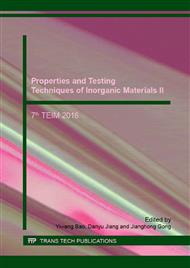[1]
S. Singh, R. Singh, Effect of process parameters on micro hardness of Al-Al2O3 composite prepared using an alternative reinforced pattern in fused deposition modelling assisted investment casting, Rob. Comp. Integ. Manuf. 37 (2016) 162-169.
DOI: 10.1016/j.rcim.2015.09.009
Google Scholar
[2]
H. R. Derakhshandeh, Effect of ECAP and extrusion on particle distribution in Al-nano-Al2O3 composite, Bull. Mater. Sci. 38 (2015) 1205-1212.
DOI: 10.1007/s12034-015-1001-1
Google Scholar
[3]
M. Ashida, Z. Horita, Effects of ball milling and high-pressure torsion for improving mechanical properties of Al-Al2O3 nanocomposites, J. Mater. Sci. 47 (2012) 7821-7827.
DOI: 10.1007/s10853-012-6679-5
Google Scholar
[4]
J. H Xu, K. Bandyopadhyay, D. Jung, Experimental investigation on the correlation between nano-fluid characteristics and thermal properties of Al2O3 nano-particles dispersed in ethylene glycol-water mixture, Int. J. Heat Mass Trans. 94 (2016).
DOI: 10.1016/j.ijheatmasstransfer.2015.11.056
Google Scholar
[5]
G. Bilir, J. Liguori, Laser diode induced white light emission of γ-Al2O3 nano-powders, J. Lumin. 153 (2014) 350-355.
DOI: 10.1016/j.jlumin.2014.03.065
Google Scholar
[6]
A. Phuruangrat, U. Cheed, T. Thongtem, S. Thongtem, High visible light photocatalytic activity of Eu-doped MoO3 nanobelts synthesized by hydrothermal method, Mater. Lett. 172 (2016) 166-170.
DOI: 10.1016/j.matlet.2016.02.141
Google Scholar
[7]
Y. C Gong, M. Yang, L. Feng, et al., Fabrication of attractive Li4SiO4 pebbles with modified powders synthesized via surfactant-assisted hydrothermal method, Ceram. Int. 42 (2016) 10014-10020.
DOI: 10.1016/j.ceramint.2016.03.104
Google Scholar
[8]
M. Zhong, Y. Li, M. Tariq, Y.M. Hu, W.X. Li, Effect of oxygen vacancy induced by pulsed magnetic field on the room-temperature ferromagnetic Ni-doped ZnO synthesized by hydrothermal method, J. Alloy. Compd. 675 (2016) 286-291.
DOI: 10.1016/j.jallcom.2016.03.062
Google Scholar
[9]
J.M. Fang, X.Y. Huang, X. Ouyang, X. Wang, Study of the preparation of γ-Al2O3 nano-structured hierarchical hollow microspheres with a simple hydrothermal synthesis using methylene blue as structure directing agent and their adsorption enhancement for the dye, Chem. Eng. J. 270 (2015).
DOI: 10.1016/j.cej.2015.02.020
Google Scholar
[10]
C. Ottone, V.F. Rivera, M. Fontana, K. Bejtka, B. Onida, V. Cauda, Ultralong and mesoporous ZnO and γ-Al2O3 oriented nanowires obtained by template-assisted hydrothermal approach, J. Mater. Sci. Tech. 30 (2014) 1167-1173.
DOI: 10.1016/j.jmst.2014.11.005
Google Scholar


